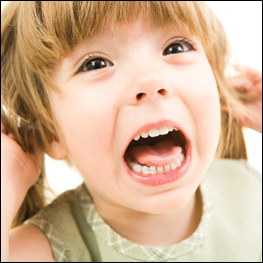
Kids test parents’ patience all the time. They whine, bargain, cry, mope and dawdle. They yell and scream and make themselves the centre of attention. Sometimes they dig their heels in and simply refuse to budge. While we may wish our kids would be compliant, cooperative and sunny in temperament, the reality is that they are doing exactly what they’re supposed to be doing. They are learning how to manage their emotions, whether it’s sadness, anger or fear. Kids do this by expressing themselves in the moment. Unlike adults, most young children don’t hold in what they are feeling. They release pent-up emotions right when they feel them, if we let them, and then they move on!
This is so healthy. As a parent, the lesson is to learn patience, rather than being ashamed and rushing children out of what they are doing. Letting children express their emotions constructively and physically helps them develop into happy, normal, full-functioning kids, teens and adults.
Here are six annoying things children do that are actually very healthy behaviors:
1. Have temper tantrums. When toddlers have meltdowns, they’re expressing their anger at injustices and violations. They release the hot, aggressive energy of anger by screaming, crying, pounding their fists and kicking. After a full-blown tantrum, small children quickly return to their sweet and joyful selves. The best thing parents can do is to allow the child to do it - safely. For older children as well as adults, parents can set up an ‘Okay Room’ where anyone can pound, stomp, yell or cry constructively when upset. Anger, sadness and fear will quickly pass, and calm will be naturally restored.
2. Cry easily. In generations past, children were told not to cry. Boys who cried were ‘sissies’ and girls who cried were ‘babies.’ In reality, tears are very healing. Research shows that crying almost immediately reduces the level of stress hormones in the body. Letting a child wail after they’ve fallen down actually helps them feel better. Crying allows kids to resolve and self-heal their physical, emotional and psychological hurts and losses.
3. Act scared. Many young kids are afraid of the dark, get scared by lightning and thunder, and feel anxious when they’re in a new place with strangers, especially without their parents. Rather than telling them, “Don’t be a scaredy cat,” validate their fear. They are feeling what they feel because their sense of safety is threatened. Fear is normal and healthy. In fact, it can be life-saving. Offer reassurances, and give them permission to shiver and quiver (kids love to do this - and they soon dissolve into laughter). Letting kids express their fear helps them stay present, rather than feeling anxious, overwhelmed and ashamed of being weak.
4. Dawdle. For parents who are focused on getting kids bathed, dressed, fed and ready for school, there’s almost nothing more irritating than a child who seems to be moving at a snail’s pace. Children have to learn how family schedules operate and how to gain mastery over new skills - and that takes time. Moving like molasses can also be a child’s way of expressing their discomfort with transitions. If you have a child who’s always one step behind everyone else in the family, instead of getting angry at your child for holding up the show, give them extra time by letting them eat in the car, for example, or by waking them up earlier. This will honor their individuality and help your child adjust at their own pace.
5. Plead and whine. Children and teens are geniuses at getting what they want and need. They plead and nag and whine until their parents toss up their hands in surrender. What they’re doing is important. They’re learning to test limits - theirs and yours - and they’re working hard to negotiate their side and be heard. It’s important that children feel their position is taken into consideration, so listen a bit to understand and validate them. It’s equally important to lovingly set and enforce reasonable limits so children learn that they’re not always going to get what they want.
6. Be resistant. When a child stomps their feet and yells, “No, I won’t do it!” they’re expressing a spontaneous emotion. Anger. Outrage. Injustice. Violation. It’s as essential that children are allowed to assert themselves as it is for adults to do this. It’s just that we’ve been programmed as parents to expect our kids to obey us. If it’s inappropriate to the situation, parents should explain to the child that they need to help and be a part of the team right now, but tell them when you will be able to listen to their side. If a child is adamant in their resistance, pause. Your child is telling you what emotions they need to express in order to feel happy. Help them find a safe place at an appropriate time and let them do that.
Jude Bijou, MA, MFT, is a respected psychotherapist, professional educator and workshop leader. Her theory of Attitude Reconstruction® evolved over the course of more than 30 years as a licensed marriage and family therapist, and is the subject of her multi-award-winning book, Attitude Reconstruction: A Blueprint for Building a Better Life. For more information, visit www.attitudereconstruction.com.
Calgary’s Child Magazine © 2024 Calgary’s Child